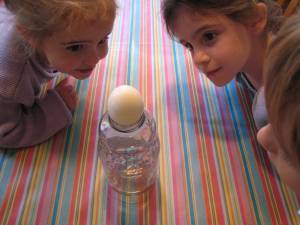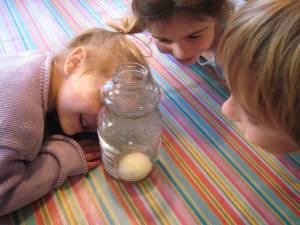Category:Physics Experiments’
Three Easy Eggsperiments
- by KitchenPantryScientist
I am cooking hard-boiled eggs as I write so that we can do a quick experiment before dinner. My kids will always drop whatever they’re doing to do a science project and I am thrilled to see them so enthusiastic about something that doesn’t involve screen time or sugar.
The first experiment involves dissolving eggshells in vinegar. Put two raw eggs into two juice glasses or jars and cover the eggs with (white or cider) vinegar. Let them sit overnight and see what happens. Before handling the eggs, gently rinse them with water. Only the membrane of the egg will remain, which is like a rubbery balloon.) It’s pretty neat. Have your child draw or record what they observed and how long it took to dissolve the shells in their science notebook. (See earlier post.)
What happened? The shells are dissolved by the vinegar, which is an acid.
The second experiment uses the eggs with the dissolved shells that you made in the one. Return the eggs to two empty glasses or jars. Cover one egg with water and the other with corn syrup. Leave them for 24 hours in the refrigerator and see what happens. Have your child record their results!
What happens? From what I understand, the balloon-like membrane of the soft eggs will let water molecules pass through. The egg will expand appear even more balloon-like as it becomes filled with water. I can’t wait to see what happens with the corn syrup egg. I’m guessing that the membrane may not let the corn-syrup molecules through. That’s my “hypothesis”, but I won’t know until we complete the experiment. Ask your child what they think will happen.
For the final experiment, you will need a glass bottle who’s neck is a little smaller than a hard-boiled egg, and the hard-boiled egg itself. It’s called Egg-in-a-Bottle. I went out to my recycling bin and discovered that my Trader Joe’s grape juice bottle is the perfect size. It obviously requires adult supervision and I have to admit that we’ve had varying sucess with this, but when it works, it’s really neat.
Peel the hard boiled egg, set it on the bottle, and let your children verify that it won’t easily squeeze through. Then, remove the egg, light three matches and drop them into the bottle. They may not stay lit for long, but it doesn’t matter. Do it fairly quickly. I had the best luck dropping them in unlit end first. Then, set the egg back on top of the bottle before the matches go out and watch the egg get sucked into the bottle. (My matches went out just before I put the egg back on top of the bottle, and it still worked.) It’s pretty cool!
Ask your kids what they think happened. Have them draw a picture of the egg in the bottle in their science notebooks! The matches heat the air in the bottle. When the matches go out, the air rapidly cools, decreasing the air pressure in the bottle. The outside air, who’s pressure is higher actually pushes the egg into the bottle as it attempts to equalize the pressure inside of the bottle.
Zooming Fish
- by KitchenPantryScientist

Here’s a fun, easy science project that I discovered a few years ago on pbskids.org/dragonflytv. My children will do it again and again. Even my three year-old joined in, cutting up construction paper into “fish food” and throwing it into the water.
You will need some sort of pan for water (a cake pan will work), construction paper, scissors, and dish soap. Have your child cut out some fish shapes from the paper (around two inches long works well.) See the photo below. Then, have them cut a small slit in the back of the tail. Put a few inches of water in the pan and add the fish. Before the paper soaks up too much water, have your child add a drop of dish soap behind the fish. The fish should zoom across the water. You will have to add fresh water tothe pan if you want to repeat the experiment.

The soap breaks the surface tension of the water. Tell your child to imagine that the surface of the water is a sheet of fabric and the soap is a pair of scissors. The soap cuts through the water, pushing the fish ahead of it. For a more scientific explanation, have your child look up surface tension or visit the dragonfly tv website!
Don’t forget those science notebooks! Have your children write the date, “surface tension” and record their results. They can try using different liquids (like lemon juice) to see if they will break the surface tension. My kids made some fish out of that foam that is used for craft projects so that they wouldn’t soak up the water! Hopefully, the zooming fish will keep your child interested and busy for a while! Click here to see a video on how to make zooming fish.


